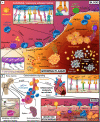Inflammatory Cell Recruitment in Cardiovascular Disease
- PMID: 33681219
- PMCID: PMC7930487
- DOI: 10.3389/fcell.2021.635527
Inflammatory Cell Recruitment in Cardiovascular Disease
Abstract
Atherosclerosis, the main underlying pathology for myocardial infarction and stroke, is a chronic inflammatory disease of middle-sized to large arteries that is initiated and maintained by leukocytes infiltrating into the subendothelial space. It is now clear that the accumulation of pro-inflammatory leukocytes drives progression of atherosclerosis, its clinical complications, and directly modulates tissue-healing in the infarcted heart after myocardial infarction. This inflammatory response is orchestrated by multiple soluble mediators that enhance inflammation systemically and locally, as well as by a multitude of partially tissue-specific molecules that regulate homing, adhesion, and transmigration of leukocytes. While numerous experimental studies in the mouse have refined our understanding of leukocyte accumulation from a conceptual perspective, only a few anti-leukocyte therapies have been directly validated in humans. Lack of tissue-tropism of targeted factors required for leukocyte accumulation and unspecific inhibition strategies remain the major challenges to ultimately translate therapies that modulate leukocytes accumulation into clinical practice. Here, we carefully describe receptor and ligand pairs that guide leukocyte accumulation into the atherosclerotic plaque and the infarcted myocardium, and comment on potential future medical therapies.
Keywords: atherosclerosis; chemokine; cytokine; integrin; leukocyte; myocardial infarction; recruitment; selectin.
Copyright © 2021 Marchini, Mitre and Wolf.
Conflict of interest statement
DW holds patents on the inhibition of the leukocyte integrin Mac-1 by peptide mimetics and antibodies (EP 2444101 A1/EP 3 260 133 A1). The remaining authors declare that the research was conducted in the absence of any commercial or financial relationships that could be construed as a potential conflict of interest.
Figures


References
-
- An G., Wang H., Tang R., Yago T., McDaniel J. M., McGee S., et al. (2008). P-selectin glycoprotein ligand-1 is highly expressed on Ly-6Chi monocytes and a major determinant for Ly-6Chi monocyte recruitment to sites of atherosclerosis in mice. Circulation 117 3227–3237. 10.1161/circulationaha.108.771048 - DOI - PMC - PubMed
Publication types
LinkOut - more resources
Full Text Sources
Other Literature Sources

